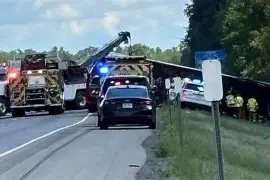Niagara Falls Tour Bus Crash: Multiple Dead and Passengers Trapped in Tragic Accident
The serene beauty of Niagara Falls, one of the world’s most famous natural landmarks, was shattered by tragedy this week when a tour bus carrying dozens of passengers crashed, leavingEmergency responders rushed to the scene amid chaotic circumstances as survivors described moments of terror.
The accident, which occurred on a major route leading to the falls, has raised serious questions about road safety, tour bus regulations, and emergency preparedness in one of North America’s busiest tourist regions. As details continue to emerge, the incident has not only stunned local communities but also shocked families of victims from abroad, as many passengers were tourists visiting from different parts of the world.
This article provides a comprehensive account of the Niagara Falls tour bus crash, including the timeline of events, emergency response, eyewitness testimony, ongoing investigations, and the broader implications for travel safety.
The Crash: What Happened?
Witnesses claimed the vehicle appeared to swerve suddenly before rolling onto its side.
The accident occurred in the late afternoon, when traffic was heavy due to both tourist activity and local commuters.
Authorities confirmed that at least four people were killed, with dozens more injured.
Several passengers were trapped inside the overturned bus, requiring firefighters to cut through the metal frame to reach survivors.
Local officials have described the crash as one of the deadliest transportation incidents in the Niagara region in recent years.
Immediate Emergency Response
First responders from Niagara Falls Fire Department, state police, and nearby ambulance services were on the scene within minutes.
Fire crews used hydraulic equipment to pry open sections of the bus and rescue trapped individuals.
Medical personnel established a triage zone near the crash site, treating the injured before transferring them to local hospitals.
Helicopter evacuations were conducted for critically injured patients who required urgent surgery.
Officials commended the speed and bravery of responders, but also acknowledged the difficulty of dealing with such a large-scale incident.
Eyewitness Accounts
One passenger, a tourist from Germany, described the moment of impact:
“Everything was normal, and then suddenly the bus swerved hard. People were screaming, luggage flew everywhere, and then we rolled. I thought I was going to die.”
Another witness, driving behind the bus, recalled seeing smoke and debris scatter across the road.
“I stopped my car and ran toward the bus. People were banging on the windows, trying to get out. It was chaos.”
These firsthand stories highlight both the trauma of survivors and the selflessness of bystanders who rushed to help before emergency services arrived.
Victims: Local and International
Authorities confirmed that the passengers included both domestic tourists from the United States and international visitors from Europe, Asia, and South America.
At least two of the deceased have been identified as foreign nationals.
Several families remain unaccounted for as officials work to contact embassies and consulates.
Hospitals in the region have reported treating more than 30 injured passengers, with conditions ranging from minor cuts and bruises to critical head and spinal injuries.
The global nature of the victims underscores the international significance of the tragedy, as Niagara Falls is a top destination for millions worldwide each year.
Investigation: What Caused the Crash?
Several potential factors are under review:
Mechanical Failure – Investigators will examine whether brake or steering problems contributed to the crash.
Driver Error – Police will interview the driver, who survived the crash, to determine if distraction, fatigue, or health issues played a role.
Weather and Road Conditions – While initial reports indicate clear skies, officials will evaluate whether road design or maintenance was a factor.
Safety Compliance – The tour operator’s history and vehicle maintenance records will be scrutinized to ensure compliance with federal safety standards.
The National Transportation Safety Board (NTSB) has been called in to assist with the inquiry, indicating the seriousness of the incident.
Safety Concerns Over Tour Buses
The Niagara Falls crash reignites long-standing debates about tour bus safety in North America. Similar tragedies in recent decades — including accidents in New York, California, and Canada — have revealed systemic concerns:
Aging fleets: Many tour buses on the road are over 15 years old, raising questions about maintenance.
Seat belt usage: While regulations have improved, many buses still lack proper seat belts for all passengers.
Driver fatigue: Long shifts and demanding schedules increase risks for human error.
High passenger loads: Tour buses often carry 40–60 people, magnifying the consequences of any accident.
Experts are calling for tighter inspections and more transparent safety reporting by tour companies.
Political and Community Reactions
Local and state officials expressed condolences to victims and pledged full support for the investigation.
The governor of New York stated:
“Our hearts are broken by this tragedy at one of our most cherished landmarks. We will do everything possible to support families, investigate causes, and prevent future tragedies.”
Community members in Niagara Falls also organized vigils for victims, underscoring the sense of collective grief in a region that prides itself on welcoming millions of visitors each year.
International Fallout
Because the bus carried international tourists, foreign governments are now involved in providing assistance. Embassies are working with U.S. authorities to identify victims, notify families, and arrange for medical evacuation where necessary.
This international dimension could prompt diplomatic discussions on travel safety standards, especially in countries that frequently send large tour groups to North America.
Broader Implications for Tourism
Niagara Falls, often called the “Honeymoon Capital of the World,” attracts over 12 million visitors annually.
Short-term impact: Tour operators may see cancellations as potential visitors weigh safety risks.
Long-term reforms: The tragedy could accelerate safety regulations and stricter licensing for tour companies.
Public relations challenge: Officials will need to reassure the global community that Niagara Falls remains a safe destination.
Past Incidents: A Pattern Emerging?
While rare, deadly bus crashes have occurred in the Niagara region before. In 2011, a tour bus carrying Canadian seniors overturned near Syracuse, killing four. More recently, smaller collisions have caused injuries but not mass fatalities.
These events highlight an uncomfortable truth: tour bus travel, though generally safe, can have catastrophic consequences when accidents occur due to the high number of passengers involved.
Calls for Change
Mandatory seat belts on all tour buses.
Real-time monitoring of driver hours to prevent fatigue.
Stricter penalties for companies with poor maintenance records.
Emergency evacuation training for both drivers and passengers.
Lawmakers are already signaling support for hearings on bus safety, suggesting that the Niagara crash could be a turning point in federal transportation policy.
Healing and Moving Forward
As families mourn and survivors recover, Niagara Falls faces the difficult task of healing from this tragedy. Community leaders stress the importance of compassion, support services, and honoring the memory of those lost.
Counseling centers have been set up for survivors, while fundraising efforts are underway to assist victims’ families, particularly those from abroad.
Though scars remain, the hope is that the lessons learned from this devastating accident will lead to safer travel standards and prevent future tragedies.
Conclusion
The Niagara Falls tour bus crash is a somber reminder of the fragility of life and the responsibility of ensuring passenger safety in one of the world’s busiest tourist hubs. With multiple dead, dozens injured, and many families shattered, the event underscores the urgent need for stronger regulations, accountability, and public awareness.
While the investigation continues, the legacy of this tragedy should not be just grief and loss, but meaningful reforms that honor the victims by making travel safer for all.
http://Niagara Falls tour bus crash multiple dead passengers trapped



